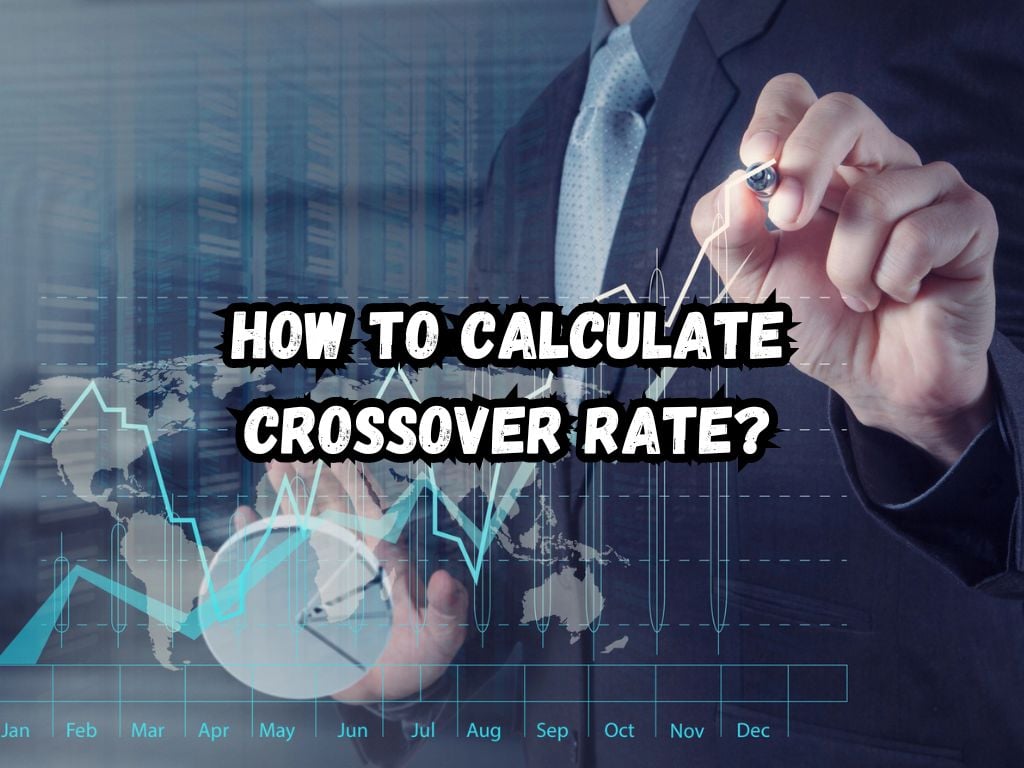In the intricate dance of financial analysis and investment decision-making, understanding, and accurately calculating the crossover rate can be a game-changer.
Two diverging paths of potential investments often pose a challenge: Which one to take for maximizing returns or minimizing risks?
The crossover rate, a key metric in comparing the value of investment opportunities, emerges as a beacon of guidance.
This article dives deep into the nuts and bolts of how to calculate crossover rate in an easy to understand manner.
With a careful blend of formulas, examples, and professional insights, you’ll gain the expertise to navigate through the complexities of investment choices wisely.
How to Calculate Crossover Rate? An Honest Guide
The crossover rate is calculated by finding the point at which two projects’ net present values (NPVs) are equal, indicating where their cost of capital is the same.
This involves solving for the discount rate that makes the difference between the NPVs of two investment projects equal to zero. Essentially, you set the equation NPV1 – NPV2 = 0 and solve for the discount rate (r).
This requires identifying the cash flows of each project, calculating their NPVs using different discount rates, and then finding the rate at which the NPVs intersect, which is the crossover rate.

Understanding the Crossover Rate
What is Crossover Rate?
At its core, the concept of the crossover rate is elemental yet profound in financial analysis. It signifies the point where two projects’ Net Present Values (NPV) — the present value of future cash inflows minus the present value of cash outflows — align.
This metric emerges from the necessity to make apples-to-apples comparisons between projects with different cash flow patterns over time.
The crossover rate illuminates the rate of return at which these two projects become equally valuable, providing a critical pivot point in investment decision-making.
The Role of NPV
Delving into NPV sheds more light on the underpinnings of the crossover rate. NPV is a cornerstone concept in finance, a quantifier of the time value of money (TVM).
It lets analysts deduce the value today of a series of future cash flows. Understanding NPV is foundational, as it’s directly implicated in the computation of the crossover rate, making it an indispensable tool in the financial decision-making toolkit.
The Mathematics Behind Crossover Rate
The Crossover Rate Formula
Translating the concept of the crossover rate into tangible equations unveils the crossover rate formula. It’s derived from setting two investments’ NPV equations against each other and solving for the discount rate, which harmonizes their values.
This formula is the bridge from theory to practice, a calculation that brings abstract financial principles down to earth.
A Practical Example
To crystalize comprehension, consider an example. Imagine two potential projects: Project A, with up-front, higher returns, and Project B, promising slower, more consistent gains over time.
After plotting their NPV profiles against various discount rates, the crossover rate is the discount rate at which the NPVs of both projects meet.
This crossing point, determined through systematic calculation, is crucial, concretizing the concept of the crossover rate from abstract theory to actionable insight.
Tools for Calculation
Utilizing Excel for Crossover Rate Calculation
Acknowledging that not all are inclined towards manual calculations, Excel emerges as a hero. It renders the task of calculating the crossover rate not only manageable but straightforward.
Populate Excel with the cash flow streams of your projects, applying varying discount rates to compute their NPVs. The point where these NPV calculations converge? That’s your crossover rate, unveiled through the wizardry of Excel’s computational prowess.
Deciphering the Crossover Rate
Interpreting Crossover Rate Results
Having calculated the crossover rate, the next step is interpretation. This rate does more than just sit pretty on a spreadsheet; it offers strategic insights. A lower crossover rate than the project’s cost of capital might nudge you towards the project with immediate, higher returns.
Conversely, a higher crossover rate signals a preference for projects with long-term, consistent cash inflows. It’s this nuanced understanding that guides astute investment decisions.
Distinguishing from IRR
The conversation isn’t complete without touching upon the Internal Rate of Return (IRR) and its distinction from the crossover rate. While both metrics serve in assessing investments, they cater to different questions.
The IRR evaluates an investment’s viability based on expected returns. In contrast, the crossover rate aids in choosing between two competing investments, using their NPVs as a basis for comparison. Each has its place in the finance toolkit, valuable in its unique context.

Avoiding Common Pitfalls
Alarmingly common are the errors that can skew crossover rate calculations. Accuracy in cash flow inputs is paramount; even minor miscalculations can lead to vastly different crossover rates.
Moreover, ensuring consistency in units across all calculation parameters is critical, avoiding basic yet impactful mistakes.
Frequently Asked Questions
How do I calculate the crossover rate for two projects?
The process involves setting the NPV equations of both projects equal to each other and solving for the discount rate. This rate is the coveted crossover rate.
What implications does a high crossover rate carry?
A higher crossover rate suggests a greater sensitivity to shifts in the discount rate. It often favors investments with gradual, sustained cash inflows over those with rapid gains.
Is it possible for a crossover rate to be negative?
Theoretically, a crossover rate should always be positive. A negative rate likely signals an error in the calculation process.
Conclusion
Demystifying the crossover rate reveals its pivotal role in informed financial decision-making. Through this exploration, armed with formulas, illustrative examples, and insightful interpretations, you’re now equipped to wield the crossover rate with confidence.
It beckons as a tool, not just of academic interest, but of practical significance, guiding investment choices with precision.
The journey doesn’t end here, though. Each calculation, each analysis sharpens your acumen, preparing you for the nuanced decisions that mark the path of savvy investing.
So, engage with the concepts, practice their application, and when in doubt, consult with financial experts to navigate complex scenarios. The power of the crossover rate, properly harnessed, opens new vistas in the realm of financial analysis.


 Tags:
Tags:










